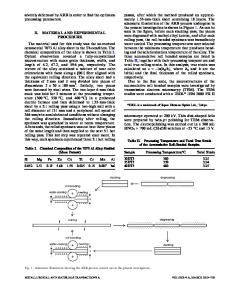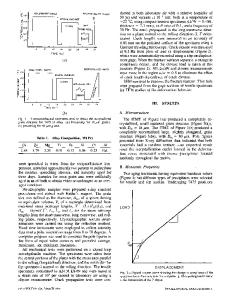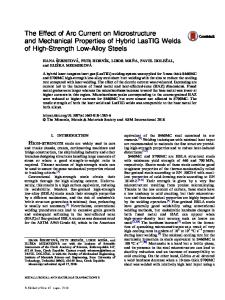The Effect of Base Metal Conditions on the Final Microstructure and Hardness of 2024 Aluminum Alloy Friction-Stir Welds
- PDF / 998,795 Bytes
- 6 Pages / 593.972 x 792 pts Page_size
- 104 Downloads / 385 Views
ION
THE welding of aluminum and its alloys has always represented a great challenge for designers and technologists. Aluminum alloys, especially 2xxx series are joined difficultly by fusion welding technique because some welding defects such as porosity and dendritic microstructure, which forms in the melted zone, can seriously weaken the joint mechanical properties.[1,2] Friction-stir welding has been well documented in recent times as an economically viable solution to the problem of joining hitherto difficult-to-weld aluminum alloys. In particular, it has attracted the attention of the aerospace industries not only due to the potential of weight and cost savings but also due to desirable retention of properties. The details of the process have been described elsewhere,[3] and in essence, they consist of a rotating probe (connected to a shoulder) that is forced into and then translated along the joint line (Figure 1). This results in high plastic deformation (e > 40) close to the probe and significant levels of frictional heating, due to contact between the tool pieces and material. Based on microstructural characterization of grains and precipitates, three distinct zones, including stirred (or
M. MOHAMMADTAHERI and E. BAHRAMI MOTLAGH, M.Sc. Graduates, M. HADDAD-SABZEVAR, Associate Professor, and M. MAZINANI, Assistant Professor, are with the Department of Materials Science and Engineering, Ferdowsi University of Mashhad, Mashhad 91775-1111, Iran Contact e-mail: [email protected] Manuscript submitted November 29, 2011. Article published online February 16, 2013. 738—VOLUME 44B, JUNE 2013
nugget) zone, thermomechanically affected zone (TMAZ), and heat-affected zone (HAZ), have been identified in a FSW weld.[4] Intense plastic deformation and frictional heating during FSW result in the generation of a recrystallized fine-grained microstructure within the stirred zone (i.e., < 10 lm).[5] The refined microstructure is attributed to the dynamic recrystallization phenomenon that takes place in the nugget zone. This phenomenon occurs when recrystallization take places during deformation at elevated temperatures. The microstructure of the weld nuggets depends on many parameters, such as rotation and transverse speeds of the tool and the geometry of the probe. Many authors have investigated the effects of these parameters on the microstructure and grain size of the weld nuggets of different aluminum alloys.[6–22] They showed that by increasing the transverse speed and reducing the rotation speed, the grain size at nugget zone decreases. This is attributed to a decrease of heat input within the weld nugget. Elangovan and Balasubramanian[19] have investigated the effect of probe geometry on grain size of the weld nugget in 6061 aluminum alloys. They showed that welding with the square probe results in finer grain structure rather than probes with other shapes, and this was attributed to pulsate stirring action in a flowing material due to the flat faces of this probe. However, little research has been carried out on the influence of init
Data Loading...











